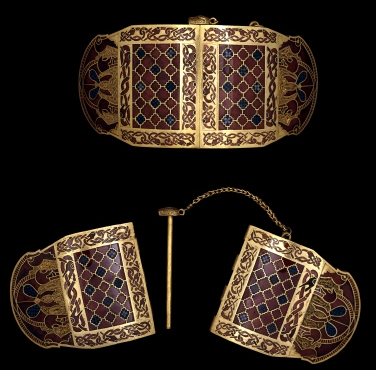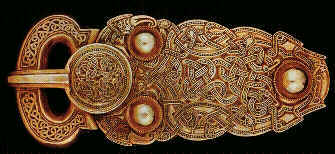


Helmet from Mound 1. Anglo-Saxon, early 7th century AD © British Museum (Mouse over for image of modern day replica) |
This iconic iron helmet covered with decorative panels of tinned bronze has come to symbolize Sutton Hoo
Only four such helmets dating to the Anglo-Saxon period have been found. The helmet has panels decorated with animals and heroic scenes. One scene shows two warriors wearing horned helmets. The other shows a mounted warrior trampling a fallen enemy. The most remarkable feature of the helmet is the facemask: it has eye-sockets, eyebrows and a nose, which has two small holes cut in it to allow the wearer to breathe freely. The eyebrows are inlaid with silver wire and garnets. Each ends in a gilt-bronze boars-head. At the top of the nose is a gilded dragon-head that lies nose to nose with a similar dragon-head placed at the end of the low crest that runs over the cap. The helmet was badly damaged when the burial chamber collapsed and had to be rebuilt like a 3-D jigsaw puzzle.
| ||||
|
These shoulder-clasps are made of gold, garnets and blue glass.
They are heavy and made in two halves, which are hinged and fastened by a strong pin, similar to a Roman style dating back several centuries. On the back are rows of staples which attached them to light-weight body armour, which must have been made of leather as no trace remained in the grave. The decoration on each half of the clasps is nearly identical - four panels containing a combination of geometric stepped cell-work within borders of animal ornaments, executed in garnet and chequerboard millefiori of intense opaque blue glass. In contrast, the four curved ends are filled with a bold design of two entwined boars made with some of the largest garnets known in Anglo-Saxon England. Their strong shoulders are picked out in large slabs of millefiori, their tusks in blue glass and their spiky crests and curly tails in deliberately small garnets. The boar was a symbol of ferocity, strength and courage.
| 
Shoulder clasps from Mound 1. Anglo-Saxon, early 7th century AD © British Museum (mouse over for close up of detail) | ||||

Purse lid from Mound 1. Anglo-Saxon, early 7th century AD © British Museum (mouse over for close up of detail) |
The purse lid from Sutton Hoo is the richest of its kind yet found.
The lid was made to cover a leather pouch containing gold coins. It hung by three hinged straps from the waist belt, and was fastened by a gold buckle. The lid had totally decayed but was probably made of whale-bone ivory. Seven gold, garnet and millefiori glass plaques were set into it. This combination links the purse-lid and the shoulder-clasps to the workshop of a single mastercraftsman, who may well have made the entire suite of gold and garnet fittings as a royal commission. The plaques include twinned images of a man standing heroically between two wolves and an eagle swooping on its prey. The wolves could be a reference to the dynastic name of the family buried at Sutton Hoo - the Wuffingas (Wolf's People). Like the eagle, they are a powerful evocation of strength and courage.
| ||||
| Like most Anglo-Saxon men, the king who was buried at Sutton Hoo wore a waist belt. These were fastened with buckles whose metal and decoration reflected the wealth and status of their owner.
This magnificent buckle was made of gold and weighs 412.7 grams. It is hollow and made in two parts joined by a hinge placed on the back beneath the loop. The master-craftsman who made it devised a locking system involving a complex system of sliders and internal rods which fit into slotted fixings. The surface of the buckle and the tongue plate are decorated with snakes and four legged beasts. Their bodies are highlighted with punched ornament filled with black niello. At the toe of the buckle, two animals hold a dog- like creature in their gaping jaws. These, together with the two birds' heads on the shoulders with curving beaks (perhaps a reference to Odin), make this buckle one of the most powerful images from early Anglo-Saxon England.
| 
Gold belt buckle from Mound 1. Anglo-Saxon, early 7th century AD © British Museum (mouse over for close up of detail) | ||||

Sword belt buckle from Mound 1. Anglo-Saxon, early 7th century AD © British Museum |
The buckle in this picture was found crushed beneath the sword.
It fastened the belt from which the sword hung. The buckle has a small oval loop, cut away shoulders and long rectangular front and black plates. The end of the belt ran between these two plates and was held securely in place by three gold rivets at the end of the buckle and two, hidden, rivets in the shoulders. The front of the buckle is decorated with panels of garnets that are deliberately set at different levels, as though to emphasize the raised central panel. All the garnets are set over gold foils which reflect light back through the stones to make them sparkle. The buckle was made integrated with four rectangular mounts that stiffened the belt, and a strap-distributor from which a strap, narrower than the belt, fell to the sword scabbard and scabbard slide. | ||||
| |||||